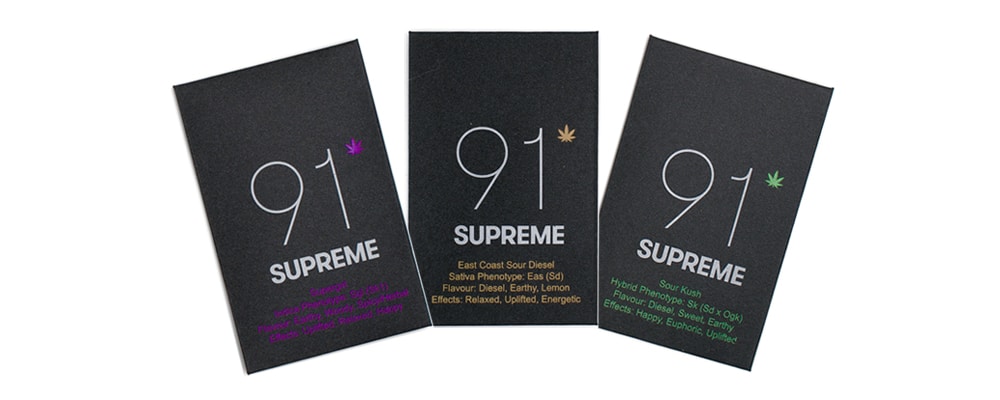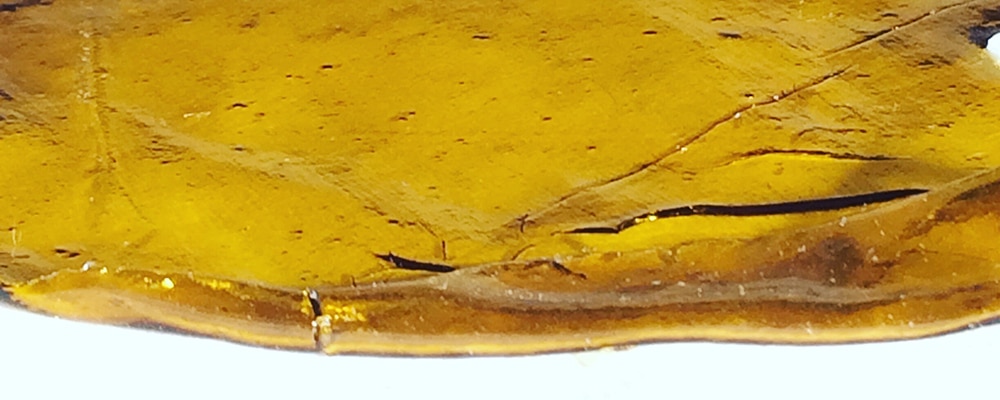Concentrates
A Complete Guide to Shatter
No, shatter isn’t some new slang word for stoned, although we could understand why newbies might confuse the two. In the cannabis space, shatter refers to a hard, hydrocarbon-extracted concentrate that resembles a glorious green shard of stained glass. The majority of people who buy shatter use it exclusively on dab rigs.
Shatter fans often rave about this concentrate’s ease of handling, delicious flavours, and mind-blowing effects. However that doesn’t mean shatter is suitable for all cannabis customers especially complete newbies.
New cannabis users should understand the pros and cons of shatter before making a purchase.
The What, How, And When Of Cannabis Shatter
Shatter is a solvent-extracted cannabis concentrate like wax, budder or sauce. However unlike these softer concentrates, shatter has a hard consistency even at room temperature. It’s this thin and almost stained glass texture that earned shatter its name.
According to most accounts, the Canadian company BudderKing deserves credit for creating the first successful batch of shatter. While BudderKing may have been experimenting with shatter in the 1990s, it wasn’t until 2003 that the company formally released this revolutionary concentrate. It didn’t take long for news of shatter’s remarkable potency and unique texture to spread through the cannabis industry.
Today, most shatter manufacturers use butane to extract the maximum cannabinoids from cannabis buds. However, it’s also increasingly common for extractors to use supercritical CO2.
Whatever solvent scientists use, they must thoroughly purge this extract before shipping it out to the public. In the case of shatter, manufacturers usually place their extract on a thin slab and hold a press in place for at least one day. This final step guarantees shatter will have its brilliantly brittle texture.
Even though concentrates like shatter go through solvent-based extraction, please don’t freak out about inhaling traces of butane. Shatter manufacturers go through extensive quality-control screenings. Companies also submit their cannabis products for comprehensive lab analyses to verify there’s no solvent residue, heavy metals, or other contaminants.

What Do People Do With Cannabis Shatter?
For most cannasseurs, shatter has just one method of use: dabbing. Because shatter is super dense, it’s easy to scoop up with a dabbing tool and place on your screaming hot nail. If you don’t like soupier sauce concentrates, cannabis shatter may be the ideal choice for your dabbing adventures.
Although dabbing is by far the most popular use for shatter, that doesn’t mean you can’t add it to a glass bong, bubbler, or pipe. Heck, you could even sprinkle a few drops of shatter into dry flowers and roll a joint.
People who enjoy vaping might also want to experiment with using shatter in their favourite device. Just be sure to double-check your vaporizer is concentrate compatible. If you use shatter in a device that’s not built for concentrates, well, your vaporizer may shatter!
What Are The Pros Of Shatter?
Like all other cannabis concentrates, shatter is beloved for its potency. Many of the shatter varieties on today’s market contain THC levels between 65 – 85 percent. So if you’re someone who needs to feel weed’s effects in a flash, shatter will get you stoned in seconds.
While potency is shatter’s main selling point, it’s not the most unique benefit associated with this concentrate. After all, dozens of other concentrates boast similarly stellar cannabinoid counts.
So what sets shatter apart from the competition?
Most significantly, shatter has the toughest texture of any cannabis concentrate. Some tokers love this feature because it’s easier for them to transfer shatter with their dabbing tools. Also, many customers claim they can dose their dab sessions more accurately when using a solid product like shatter.
While shatter has a huge fan base in the cannabis community, that doesn’t mean everyone’s in love with this concentrate’s brittle consistency. Indeed, one of the annoying features of using shatter is that it often gets stuck to storage containers. Some dabbers simply prefer to use “looser” concentrates like budder, wax, or sauce.
Choosing whether to use shatter versus other solvent-extracted concentrates is mostly a matter of personal preference. All of these products offer similarly intense experiences, but they have very different densities and texture. It’s a good idea for new cannabis users to try different concentrate consistencies to figure out what’s most convenient for them.

What’s The Best Way To Store Shatter?
While many customers like to leave their shatter in the product’s original packaging, that’s not the most optimal for long-term storage.
If possible, store your shatter in an airtight container far from light and heat. The more light that penetrates your shatter, the quicker it will degrade in potency.
For the best results, wrap your shatter in parchment paper before putting it in your airtight container. This simple hack will prevent shatter from sticking to your container’s interior.
If you want to keep your shatter for the long haul, you can place it inside the refrigerator. Just be sure to wrap your shatter in parchment paper and seal it in an airtight bag.
These strategies will reduce the risk of oxygen and water exposure—both of which will degrade your shatter’s quality. As long as you store your shatter correctly, it should maintain its peak potency for a few months at room temperature. Shatter that’s stored in the fridge could last as long as one year.
Is Pull ‘n’ Snap The Same As Shatter?
Even though all shatter products follow similar extraction procedures, they can have slightly different consistencies. In fact, one shatter variant is so widespread that it has gained its own nickname: pull ‘n’ snap!
Unlike the dense glass consistency we typically associate with shatter, pull ‘n’ snap has an elasticity similar to sticky caramel candy. As its nickname implies, customers could pull on this concentrate with their hands rather than breaking it with a dabbing tool.
Interestingly, the primary reason pull ‘n’ snap is looser than traditional shatter has little to do with how it was manufactured. While different extraction technologies could influence shatter’s consistency, cannabinoid counts seem to play a more significant role.
Generally speaking, if your shatter is incredibly tough, chances are it has more THC-A than THC. By contrast, shatter varieties with more THC than THC-A end up in the pull ‘n’ snap category.
Since THC-A will transform into THC when you light your shatter, this difference doesn’t significantly alter shatter’s effects. For some strange reason, these different cannabinoid percentages only seem to influence shatter’s texture.
If you’re having a hard time getting use to the consistency of pull ‘n’ snap, you could pop it in the freezer for about 15 – 30 minutes. This short chill down will make your concentrate more like the traditional shatter.
What’s The Deal With CBD Shatter?
Although BudderKing initially created shatter with high-THC strains, that doesn’t mean CBD shatter doesn’t exist.
Indeed, since CBD has become more and more popular in recent years, demand for CBD shatter is on an uptrend.
Unlike THC, CBD won’t make you feel high even at higher doses. Many people who take high-potency CBD extracts notice enhanced mental clarity and calm. This makes products like CBD shatter fantastic for days when you want to feel cannabis’s healing effects and remain productive.
Just keep in mind that high-potency CBD shatter can still have powerful effects on new users. If you’ve never tried cannabis or hemp before, smoking CBD shatter could make you feel sleepy. New users should first try a lower potency CBD product at home to gauge how this cannabinoid affects them. Once you’ve gained some experience with CBD edibles and tinctures, you should feel more comfortable transitioning to CBD concentrates.

Can I Make Cannabis Shatter At Home?
Shatter is not a DIY concentrate. Even if you have some technical knowledge, it’s never a good idea to make this extract at home. The only people who should make shatter are trained technicians who have access to a controlled, hi-tech lab environment.
Not only is it expensive to make shatter at home, it’s incredibly dangerous. Solvents like butane are highly flammable, which means it’s possible you could “shatter” your home while making this concentrate.
Rosin is one of the few concentrates cannasseurs should consider making at home. Unlike shatter, rosin is a solventless cannabis concentrate that’s made with heat and pressure. While there are professional rosin presses for sale, concentrate fans could use parchment paper and a hair straightener to make this sticky concentrate.
Compared with shatter, rosin has a stickier consistency, reduced purity, and a weaker potency. However since rosin is cheap to make, it remains quite a popular concentrates in today’s cannabis market.
Is It OK For Beginners To Smoke Shatter?
Shatter isn’t the best choice for people who are brand new to smoking cannabis. Indeed it’s not recommended anyone with minimal marijuana experience experiment with dabbing concentrates. Since your body isn’t accustomed to THC, there’s a good chance you could have an adverse reaction to high-proof products like shatter.
First-time tokers should start off with less intense products like joints or vape juices. You could also experiment with cannabis edibles, oils or tinctures before moving up to concentrates.

Want A Smatter Of Shatter? BC Bud Supply Can Help!
Despite its relative youth, shatter is a staple in today’s concentrate market. To help meet the increased demand for this brilliantly brittle concentrate, BC Bud Supply now offers a plethora of shatter brands to choose from. Each shatter product in our portfolio has between 65 – 85 percent THC and zero traces of heavy metals, pesticides, and other icky compounds.
For more details on check out BC Bud Supply’s shatter catalogue.
